Table of Contents
Table of Contents
- 1. Most Agencies Are in the Growth Stage, With Potential To Move to the Premier Level
- 2. SEO and Website Design & Maintenance Are the Most Popular Services
- 3. Instagram Campaigns Will Receive Increased Traction in 2024
- 4. Influencer Marketing May Take a Backseat, Contrary To Last Year’s Findings
- 5. Over Half of Agency Clients Sign up for 3+ Services
- 6. A Long-Term Retainer Is the Preferred Pricing Model for Most Clients
- 7. Client Acquisition Continues To Be the Top Agency Challenge for 2 Years in a Row
- 8. Agency Leaders Credit Referrals as Their Most Promising Source for New Business
- 9. Economic Uncertainty Is a Major Concern–Even More Than the Rise of AI Tools
- 10. 36% of Agencies Increased Prices Due to Rising Inflation
- 11. Agency Leaders Predict a Surge in AI Usage Over the Next 5 Years
- 12. Most Agencies Have Upped Their Revenue Over the Past Year
- Agencies Continue To Demonstrate Their Adaptability and Resilience
7,000+ agencies have ditched manual reports. You can too.
Free 14-Day TrialQUICK SUMMARY:
AgencyAnalytics surveyed 251 marketing agency leaders to capture their views and perspectives on the current state of the industry. This article provides a comprehensive overview of key topics like AI usage, economic uncertainty, and client acquisition strategies. It also highlights prevalent challenges and shares expectations for the year ahead.
No two days are the same in marketing…so imagine what happens in a year.
From the rapid evolution of AI tools to ongoing economic uncertainty, 2024 has brought myriad challenges that have forced marketing agencies to innovate, pivot, and adapt their strategies to remain successful. Amidst so many changes, it’s natural to wonder, “How does my agency stack up to the competition?”
To bridge this gap, we’ve surveyed 251 agency leaders to get their feedback on exactly what’s happening in the industry. This article also builds on findings from 2023, such as the most common client acquisition methods and revenue predictions.
In Part One of our two-part series, we examine the industry trends that are currently shaping the activities of marketing agencies like yours. In Part Two, we dig deeper into marketing agency management trends.
Dig into 2024's findings to explore what most agencies were experiencing last year and how those trends continue to shape the industry today. For the most up-to-date insights, check out the 2025 Marketing Agency Benchmarks Report.
1. Most Agencies Are in the Growth Stage, With Potential To Move to the Premier Level
The majority of agencies have 1 to 5 full-time employees, which corresponds with the growth and establishment phase of the digital agency life cycle.

Similarly corresponding to the growth and establishment phase, the majority of agencies surveyed maintain a roster of 11 to 20 clients. It’s an exciting place to be–there’s ripe potential for expansion, acquiring more market share, and eventually becoming a premier-level agency.
Transitioning from a small to a medium-sized business definitely comes with many growing pains. Still, we've remained flexible when it comes to meeting the needs of existing and prospective clients. You have to be intentional about your actions to move the company forward. It’s important to invest in things like technology and prioritize long-term goals.
Stena Lambert, Director, Vortala Digital
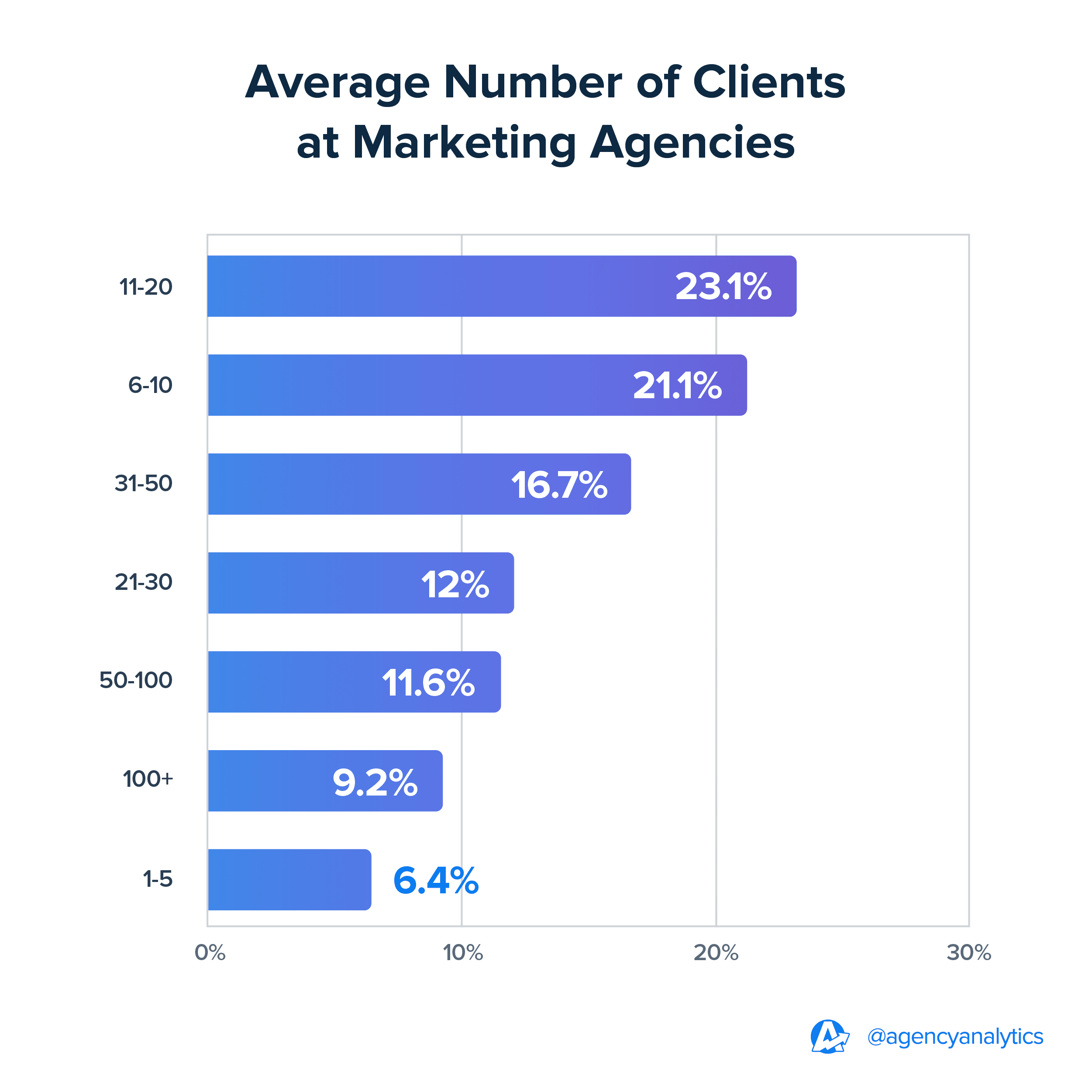
At this stage, it’s important to plan for potential growth and put the right structures in place. This looks like:
Ensuring Your Team Is Well-Distributed Across Projects: This might involve hiring additional full-time resources to meet growing client needs. Alternatively, explore freelancers to handle an overflow of work or perform specialized job functions (e.g., complex website coding).
Diversifying Service Offerings to Cater to a Broader Range of Client Needs: This could include adding new services or creating more competitive packages (which we’ll touch on later).
Building Strong Relationships Through Regular Check-Ins and Personalized Services: Remember–happy clients are more likely to provide repeat business, referrals and sustained revenue.
Retaining existing customers is often less expensive than acquiring new ones. By focusing on personalized communication, upselling, and cross-selling, we have been able to increase the lifetime value of each customer and reduce our overall CAC.
Adam Binder, Founder & CEO, Creative Click Media
2. SEO and Website Design & Maintenance Are the Most Popular Services
Agencies have identified SEO and Website Design & Maintenance services as their top provided offerings, with both tying for first place. Following closely are PPC (77%) and Social Media Marketing (75%).
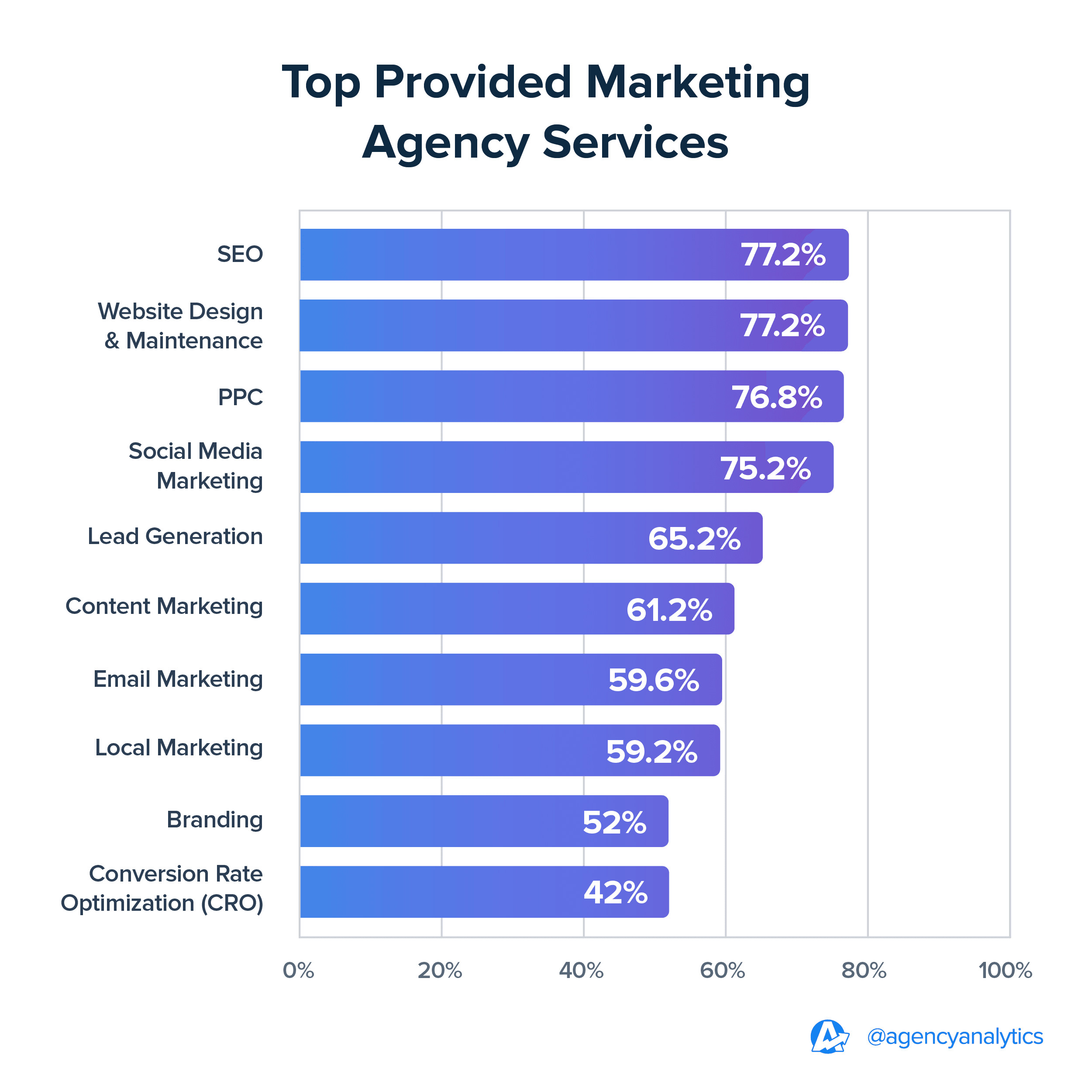
This indicates that clients are increasingly focused on building their organic presence, optimizing for search, and enhancing online visibility. A well-designed website complements these goals, so it’s no surprise that design and maintenance are top priorities.
Good design is not just a nice-to-have; it’s a critical component of success. That's why our agency focuses on web design, SEO, PPC, and social media. A website is often the first point of contact between a business and its potential customers, which is why we prioritize the user experience. By helping our clients build a strong online presence, we empower them to connect with their customers and grow their businesses meaningfully.
Adam Binder, Founder + CEO, Creative Click Media
It is worth noting that not all client industries have experienced a surge in demand for SEO and web design–in conversations with our community of more than 7,000 marketing agency professionals, we understand that web design agencies serving SaaS clients have experienced a slowdown. We’ll provide more detail on the possible causes for economic sluggishness later in this report.
3. Instagram Campaigns Will Receive Increased Traction in 2024
Which marketing platform holds the most promise for the year ahead? According to 60% of agency leaders, it’s Instagram.

While Facebook continues to take the top spot for the most-used social media platform, consider that:
There are 169M Instagram users in the US, primarily in the 18 to 24 and 25 to 34 age groups. Therefore, Instagram is an opportunity to reach Millenials and Gen Z in a creative, impactful way.
On average, users spend 33 minutes on Instagram per day. Whether it’s scrolling through their feed or looking at the Explore page, this platform has become an essential part of many people's daily routines.
Instagram's projected ad revenue for 2024 is 70.9B. In other words, there’s an opportunity to create paid campaigns that yield positive ROAS.
In 2024, agencies should use this visuals-first platform to its fullest potential. More specifically, consider focusing on content like Stories, live videos, and Reels–anything that quickly captures user attention. Given that 90% of marketers report significant ROI from video marketing, it’s certainly worth prioritizing for the upcoming year.
Video is a big part of our strategy–it's the most informative and interesting way to get your message out. From dynamic animated logos to how-to videos and short-format social media videos, video hits all the marks for introducing our clients to solutions, putting our brand out there, and catching your eye in a high-value way!
Michelle van Blerck, Communications Manager, Digital Freak
4. Influencer Marketing May Take a Backseat, Contrary To Last Year’s Findings
Here’s a surprising stat: 24% of agencies plan to invest less in influencer marketing. Last year, it was projected to be the most promising campaign type.
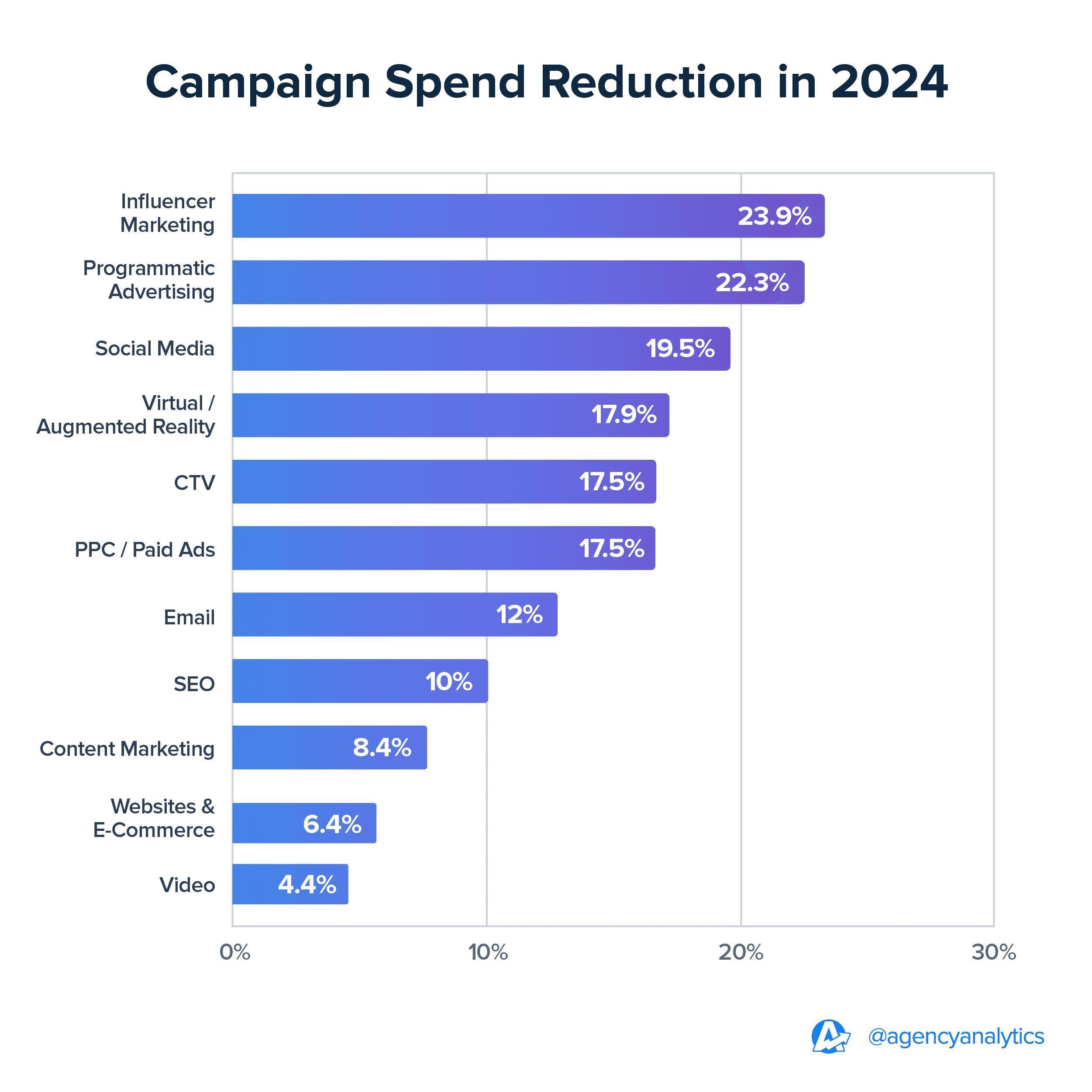
Why has this scale tipped in the opposite direction? Here are a few possible reasons:
Market Saturation: The worldwide influencer market has a value of 24B, which is an increase of almost 3B from last year. With this level of saturation, it may be difficult for influencer campaigns to make the same impact.
ROI Concerns: While influencer marketing could be effective, quantifying success remains challenging. For example, increased brand awareness may be difficult to show in the absence of more tangible results (like online sales).
Cost Increases: The rising fees for top-tier influencers may not justify the returns, especially for clients with limited budgets.
Changes in Consumer Behavior: Audiences are becoming more aware of sponsored content. Therefore, there’s an increased chance that influencer content seems less genuine, which could lead to diminished results.
While influencer marketing is still a powerful strategy, choose representation wisely. For instance, a micro-influencer with aligned brand values may make a more significant impact than a more popular social media figure.
In other words, ensure the partnership actually makes sense for your client. As a reference, watch for these influencer red flags.

5. Over Half of Agency Clients Sign up for 3+ Services
Juggling multiple service providers is time-consuming and makes it difficult to achieve a cohesive market strategy. That’s likely why more than half of clients opt for 3+ services when working with a marketing agency.
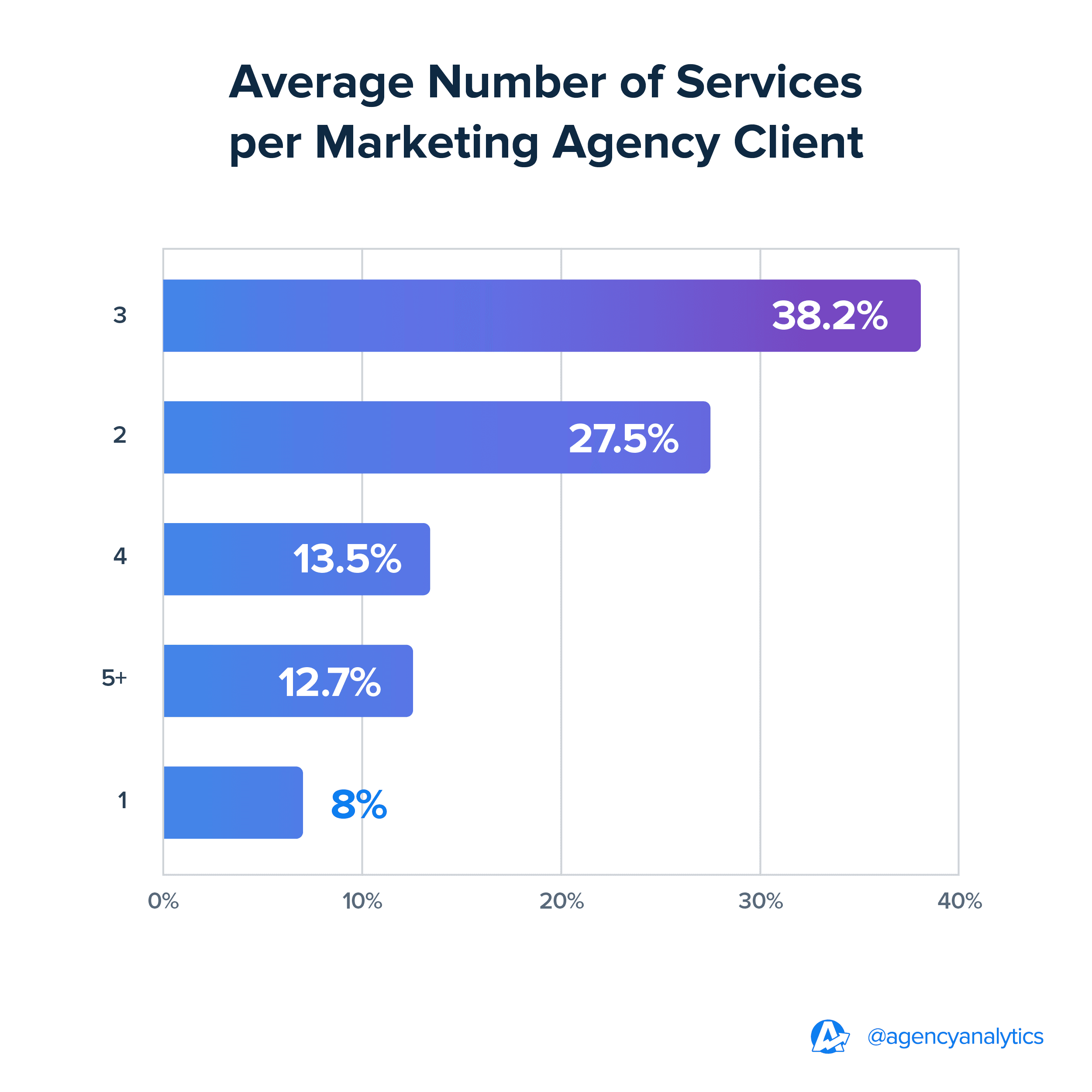
What are the implications of this finding? It’s an opportunity to:
Develop Value-Based Packages and Simplify the Client Experience: This approach eliminates the need to explore other providers, all while positioning your agency as a one-stop solution.
Upsell Additional Services That Clients Might Not Have Considered Individually: It’s a strategic way to attract repeat business, increase a client’s lifetime value, and generate more revenue.
Make recommendations based on what a client genuinely needs–even if it means forgoing revenue potential.
Only upsell services that are absolutely necessary for your clients to meet or exceed their goals. If you don't, then you will erode that relationship over time. Don't sell them fluff because they'll buy it, and neither of you will be better for it.
Jeremy LaDuke, Founder, Epic Nine
6. A Long-Term Retainer Is the Preferred Pricing Model for Most Clients
Here’s another complementary stat: 43% of agencies report retainers are the most popular package type.
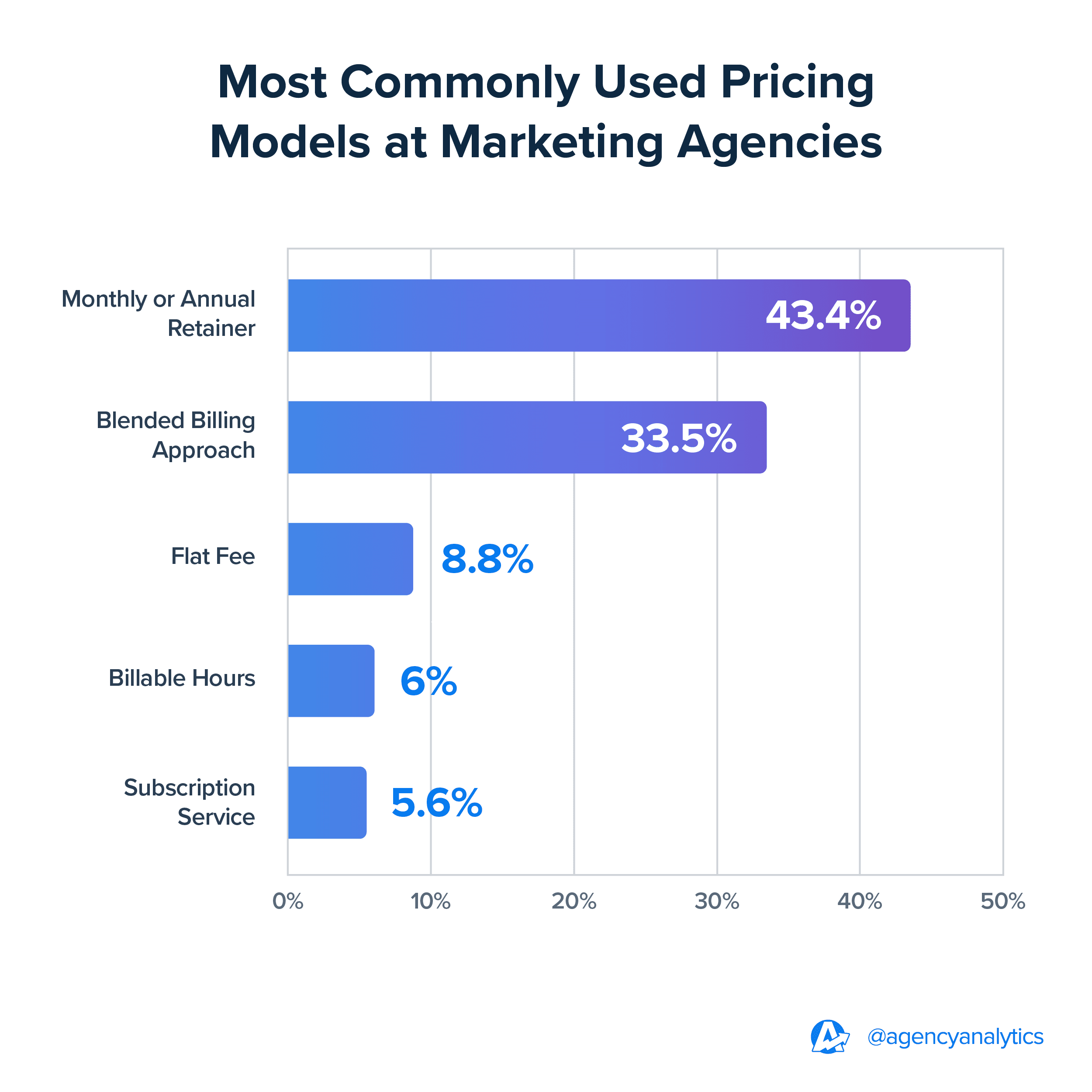
This pricing model provides clients with predictable expenses, helping them budget and plan ahead. It’s also a strategic way to create a recurring revenue stream and some level of financial stability.
In other words, there’s tremendous value in building long-term relationships–both for agencies and their clients.
Look at what provides recurring revenue without a lot of labor. We call it “mailbox money.” It’s easy to focus on getting that next $5k or $10k/month client instead of 100 people who can pay $100/month instead.
Ryan Kelly, CEO, Pear Analytics
7. Client Acquisition Continues To Be the Top Agency Challenge for 2 Years in a Row
Here's a trend we've observed over the past two years: Acquiring new clients continues to be the most significant challenge for marketing agencies.

Due to the frequent urgency of client deliverables, agency teams also grapple with time pressure and stress.
While there’s no magic solution to these occurrences, here are a few buffers:
Take a Proactive Approach to New Client Acquisition: Instead of waiting until churn happens, intentionally focus on building a pipeline of potential clients. For example:
Share Past Successes: Source testimonials from existing clients to boost your brand authority and credibility.
Leverage Your Contacts: Offer referral incentives to existing clients (e.g., a free month of social media management services).
Expand Your Network: Attend industry-related events to network, share your expertise, and make new connections.
Set Realistic Deadlines and Manage Workloads: Regularly provide updates on project progress, which helps manage client expectations. Also, check in with your staff to ensure they’re not overburdened or burnt out.
Use Automated Tools To Manage Client Deliverables: Invest in scalable solutions (like a client reporting tool) to streamline task management and improve operational efficiency.
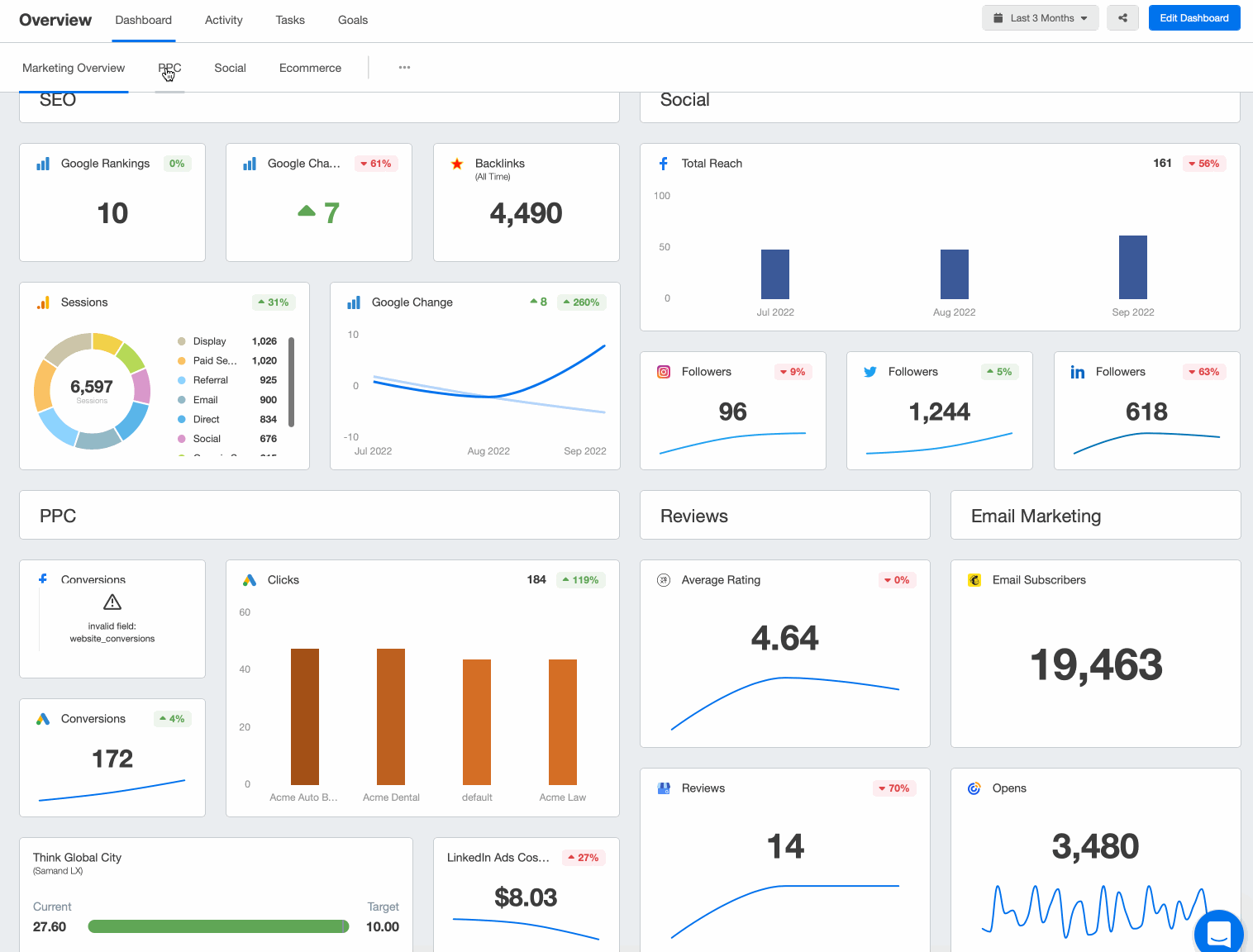
Show clients exactly why they should partner with your agency. Use AgencyAnalytics to monitor real-time metrics, create professional reports, and improve retention rates–try it free for 14 days.
8. Agency Leaders Credit Referrals as Their Most Promising Source for New Business
Speaking of client acquisition, referrals continue to be the top source for acquiring new business. In fact, this is another pattern we’ve seen since our last benchmark report.
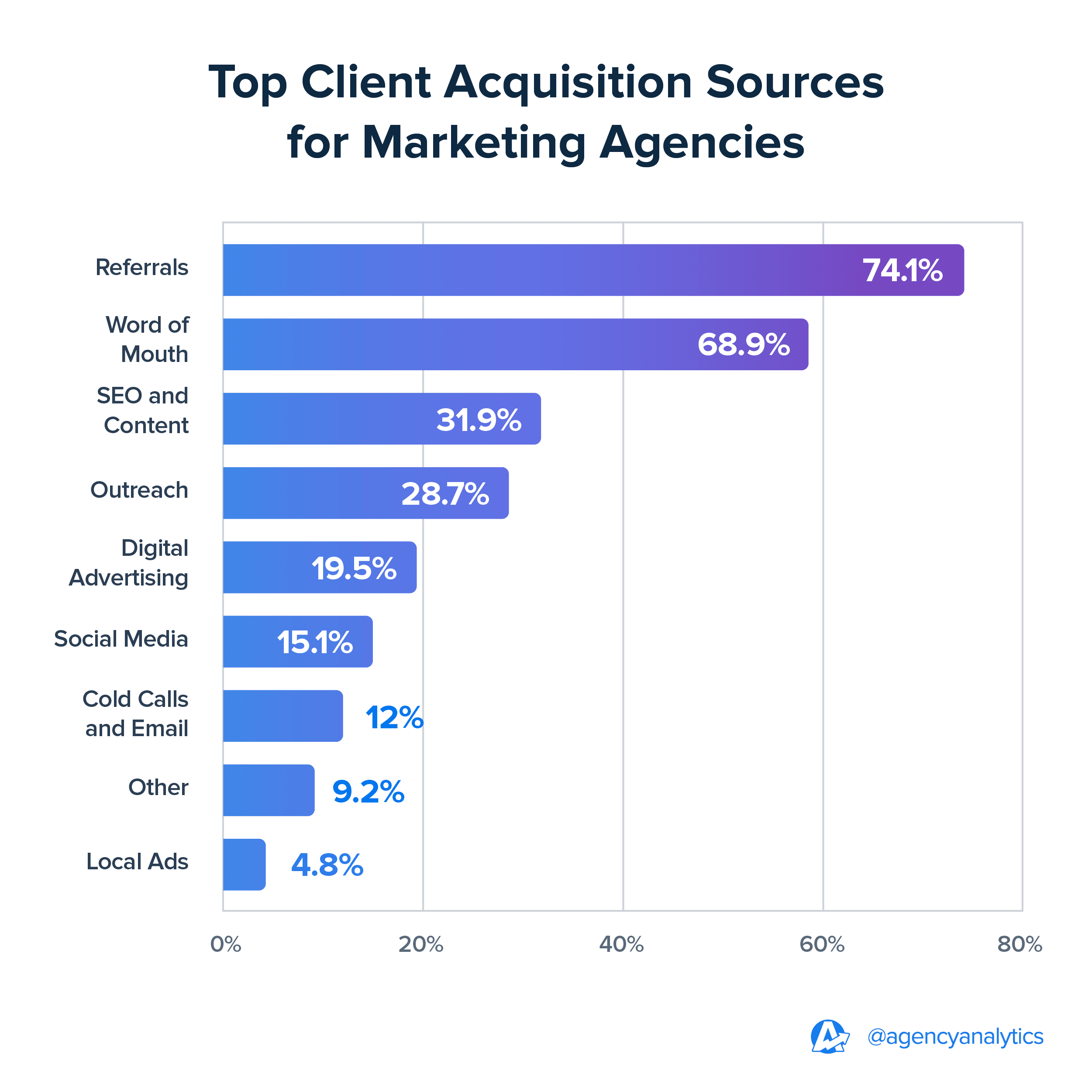
Interestingly, it’s a more impactful acquisition strategy than focusing on SEO and content marketing to grow the agency (the most requested agency service mentioned earlier). It shows the power of intentional relationship-building, even if your services or operations are primarily digital.
Our personalized approach might seem 'old school' to some, but it allows us to build strong connections with potential clients. We go beyond just the marketing ask–we want to understand a client’s company culture, how they treat customers, and their internal processes. This ensures a good fit for both parties. We continuously analyze what works best in nurturing these relationships, always striving to find the ideal clients who truly value our partnership.
Ryon Gross, CEO, Local Leap Marketing
9. Economic Uncertainty Is a Major Concern–Even More Than the Rise of AI Tools
We’re all feeling the pinch somehow. So it doesn’t come as a surprise that agencies have cited economic uncertainty as their top concern in 2024.
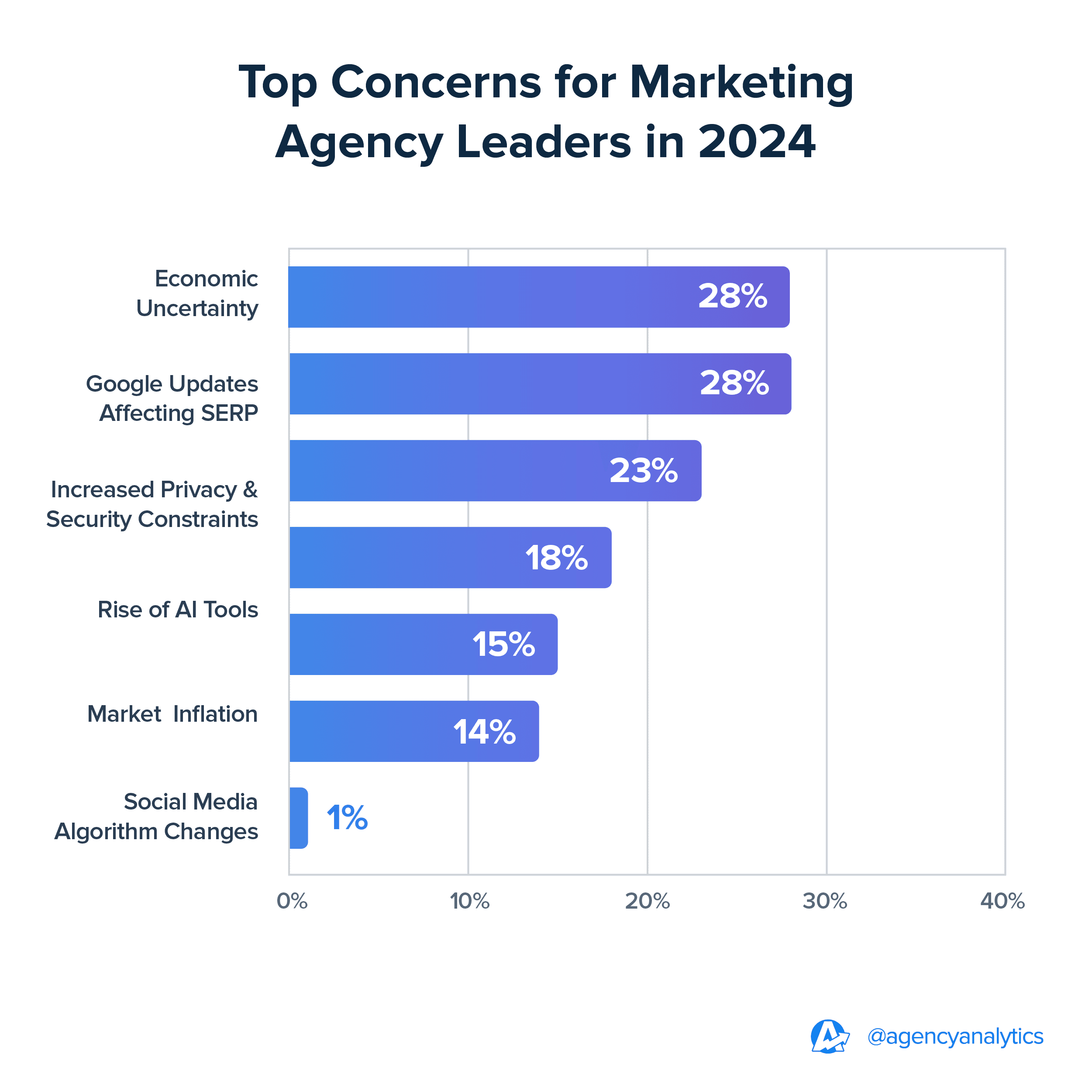
For more context, it’s helpful to look back at where we’ve been. In 2023, US consumers spent significantly less on digital advertising initiatives. In fact, it was the lowest yearly growth rate since the recession period in 2009 (7.8% in the U.S.). From the agency end, this may have meant the following:
Clients spending significantly less on marketing efforts and focusing on short-term business survival strategies.
Internal hiring freezes and layoffs due to a reduced cash flow.
Fewer contract renewals, less projects in the pipeline, and higher than average churn rates.
2023 was an abysmal year. We talked to many agencies that were down 50%, and some of the best-in-class were flat for the year.
Miles Kailburn, CEO & Co-Founder, OTM
It isn’t necessarily all doom and gloom on the horizon, though. At the end of 2023, there was higher than expected economic growth. This could mean an improved business outlook for 2024 (fingers crossed), though we won’t know until time progresses.
Aside from the economy, 38% of agencies expressed concern about changing Google algorithms and residual effects on SERP positions. Over the past year, there’s been the emergence of generative AI for search, the official phasing out of Universal Analytics, and continuous adaptation to GA4.
Interestingly, despite the exponential increase in AI usage from last year to this year, the rise of AI only ranks as the fourth most pressing concern today. While worries about marketing agency job redundancy are likely something you’ve addressed with your own staff, it seems that some of the panic has worn off in 2024.
To summarize, there have been many changes in a relatively short time. While some fluctuations are expected, this doesn’t change the fact that clients still have goals to meet.
While some things are out of your control, one thing isn’t–monitoring and sharing results. It’s a way to demonstrate what you’ve worked on, communicate goal progress, and keep transparency on the table.
One of the biggest SEO-related challenges we’ve faced in recent years is the constantly evolving search algorithms. As these happen, strategies that were once effective may become less so. To overcome this challenge, we stay up-to-date with the latest SEO trends and adapt our strategies. We also conduct ongoing research and testing, which ensures that we are delivering optimal results for our clients. We also use AgencyAnalytics to monitor campaigns in real-time, make data-driven decisions, and save time on reporting.
Daniel Dye, President, Native Rank, Inc.
10. 36% of Agencies Increased Prices Due to Rising Inflation
Building on our last point, just over half of agency leaders have reported that they’ve experienced notable challenges due to inflation.

For added context, consider that the inflation rate in the US increased by 3.3% as of May 2024 (compared to the same period last year).
It’s no secret–inflation affects the bottom line. Agencies may have experienced a dent in profits or even skewed financial projections. It’s a result of:
Paying More for Outsourced Services: Suppliers may also be experiencing the burn of increased living costs, which could result in higher agency expenditure (e.g., printing promotional materials may be more expensive than last year).
Increased Overhead Costs: Inflation often leads to higher property rental costs, especially if you’ve got an office in a prime location. Also, consider any incremental price increases to software subscriptions or other frequently used services–these also affect profitability.
Higher Salary Demands From Employees: Internally, your team members may expect adjusted wages or a more considerable incremental increase as they cope with rising costs.
Of these 146 agencies affected by inflation-related pressures, 36% have actively decided to raise their prices.
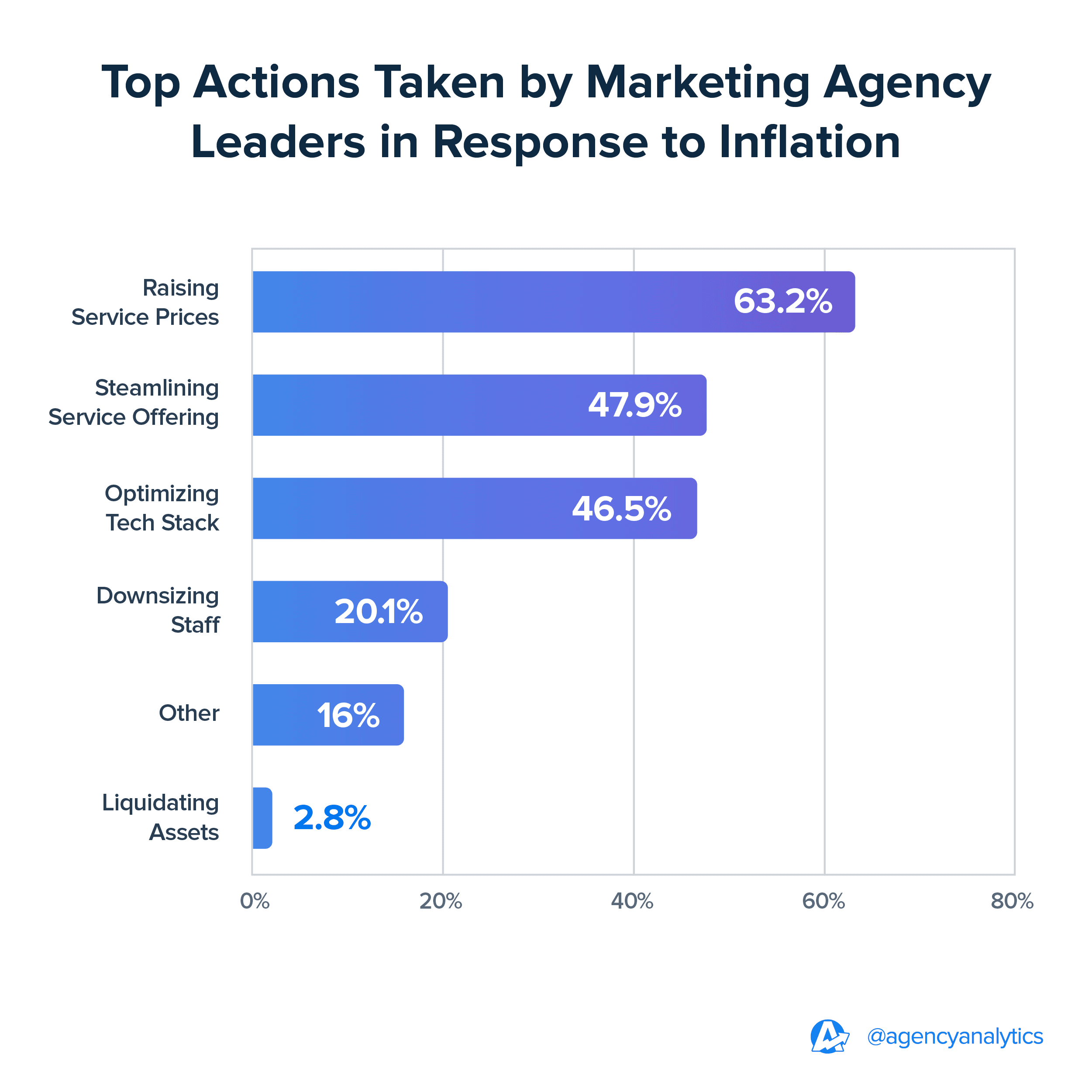
Changing your pricing structure (especially if you have long-standing or legacy clients) is uncomfortable. There’s the risk of losing business, strong client objections, and even feelings of impostor syndrome on your end.
That said, remember that your agency is a business. If your delivery margins are dwindling, it’s time to reevaluate. It’s not about jarring clients with a sudden or exorbitant price increase, though. Here are some pointers to ensure a more seamless transition.
Strategy | Description |
|---|---|
Develop a Justification for Price Changes | Document any increases in costs (e.g., software, labor). Also, highlight any additional value service changes since the last pricing update. |
Provide Clients With Ample Notice | Communicate pricing changes at least 3 to 6 months in advance when possible. |
Schedule 1:1 Meetings | Maintain an open-door policy to discuss these changes and any pending concerns. |
11. Agency Leaders Predict a Surge in AI Usage Over the Next 5 Years
A whopping 86% of agency leaders agree that AI usage will continue to grow, with no signs of slowing down.

The marketing industry has experienced the first-hand impact of AI, even more so than other sectors. In a short space of time, it’s revolutionized many facets of daily operations, like content ideation and social media calendar planning (to name a few). While it may have been met with some apprehension–especially where job security is concerned–it continues to be a highly-used, time-saving tool. And according to most agency leaders, it’s here for the foreseeable future.
AI isn't going away, and putting our heads in the sand won't help. We need to look at how we can use these new tools to create a competitive advantage.
Tim Akers, Founder, Akers Digital
It’s impossible to predict exactly what AI developments will look like in the upcoming future. However, it’s important to get comfortable with these tools, leverage their capabilities, and stay one step ahead. It’s probably why 77% of agencies have already implemented AI-driven processes in their day to day tasks.
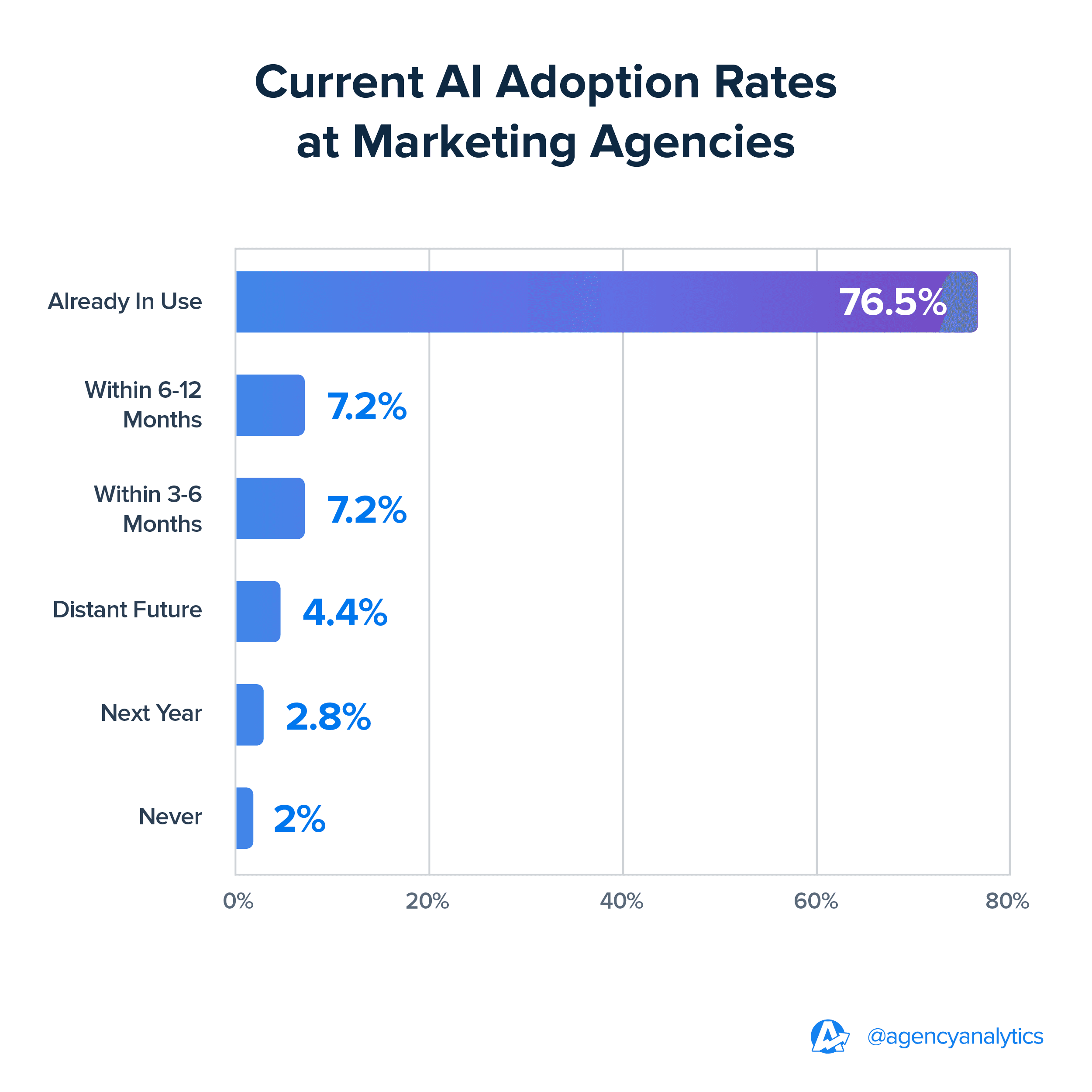
To get the most from AI tools, consider:
Creating Internal SOPs for Each Department: Develop detailed guides on how to use AI tools for different job functions at your agency (e.g., prompts for copywriting and graphic design). Assign owners for these living documents and update them as needed.
Regularly Monitoring AI-Related News: Sign up for Google Alerts (e.g., receive notifications for a term like “AI in marketing”) and industry-related newsletters. In other words, have a system in place to keep track of real-time developments that could affect your internal workflows.
Encouraging Team Members To Enroll in AI-Focused Training: For example, this may mean taking a supplementary course from Coursera or Udemy. If you’re using AI for more complex tasks (e.g., advanced customer segmentation for email lists), explore in-house workshops or advice from external experts.
12. Most Agencies Have Upped Their Revenue Over the Past Year
Despite lingering reservations about the economy, approximately 66% of agencies reported a rise in revenue. In fact, most agencies experienced an earnings increase of 25% or more.
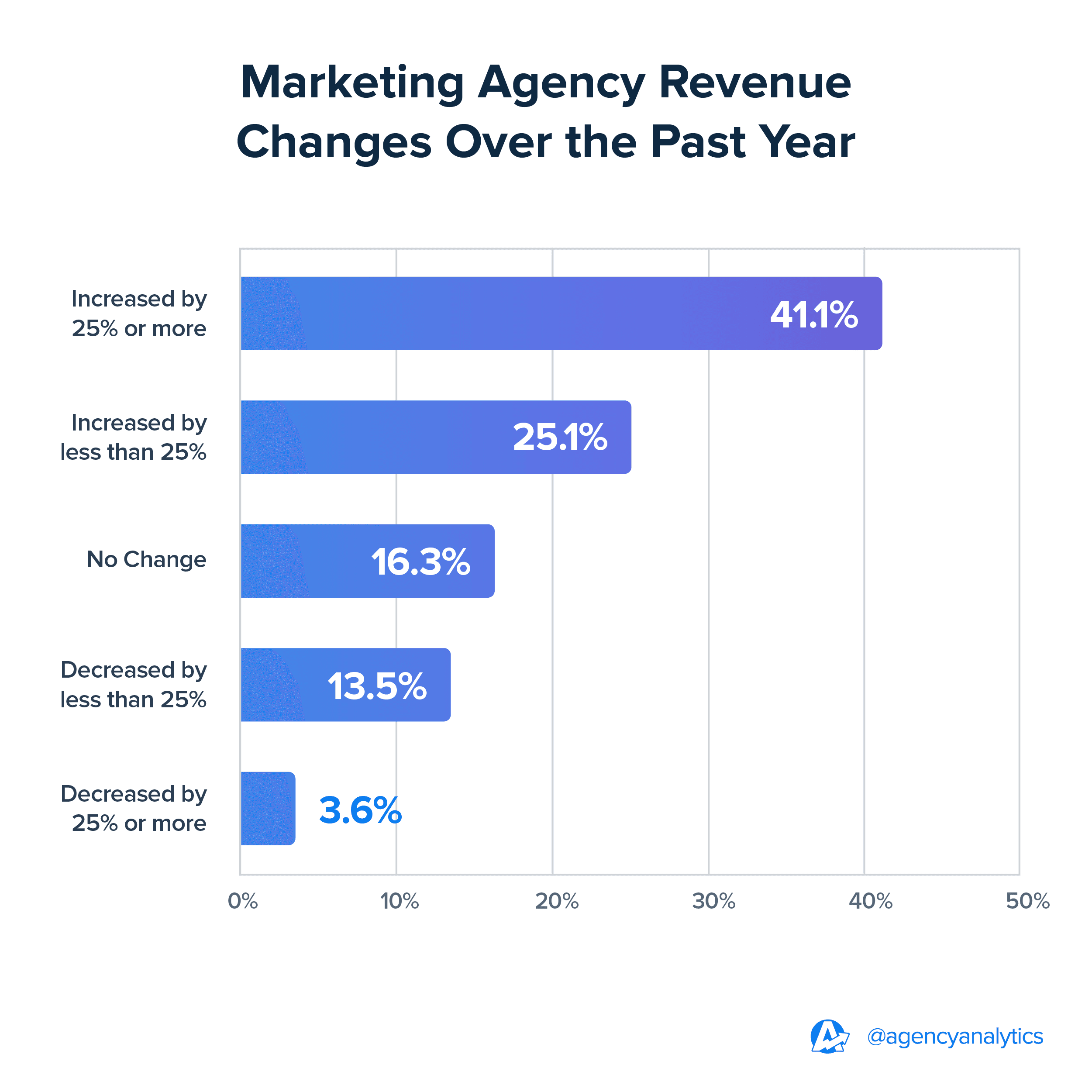
This trend is predicted to continue, with optimism of even more revenue in the upcoming year (as expressed by 43% of agencies). It’s a testament to their persistence, even amidst evolving market conditions and industry-related changes.

Agencies Continue To Demonstrate Their Adaptability and Resilience
As we’ve seen, there’s no shortage of evolving challenges–most notably, wavering economic conditions and the grind to continually generate new business.
Even so, agency leaders have continued to steer their businesses upward. From building long-term partnerships to integrating internal AI-driven processes, they’re making strategic adjustments when necessary.
Here are some takeaways from these findings:
Where Possible, Create Value-Based Packages: This will encourage relationship-building while resulting in more sustainable revenue.
Create Relevant Growth Goals: While it’s insightful to understand what other agencies are doing, your journey is unique. Whether it’s nurturing existing client relationships or increasing your headcount, have a clear idea of precisely what you want to achieve.
Adopt a Proactive Approach to Client Acquisition: Churn is a natural part of agency life. Instead of addressing it reactively, build your network and attract potential clients on a regular basis.
Use the Right Systems To Improve Operational Efficiency: Invest in tools like AgencyAnalytics to maximize billable time, ensure data transparency, and share meaningful results–try it free for 14 days.
Leverage these insights to assess your agency’s performance, learn from peer experiences, and plan ahead. Data is your biggest ally, after all.
Looking for more marketing agency insights? Keep reading Part Two of our Marketing Agency Benchmarks Survey findings, where we discuss agency management trends and challenges. And be sure to download the 2025 Marketing Agency Benchmarks report for all the latest findings!

Written by
Faryal Khan is a multidisciplinary creative with 10+ years of experience in marketing and communications. Drawing on her background in statistics and psychology, she fuses storytelling with data to craft narratives that both inform and inspire.
Read more posts by Faryal KhanSee how 7,000+ marketing agencies help clients win
Free 14-day trial. No credit card required.






